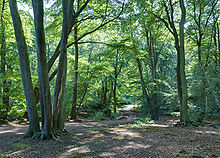
Back Epping Forest CEB Epping Forest Czech Epping Forest German Bosque de Epping Spanish Epping basoa Basque اپینگ فورست Persian Epping Forest Finnish Epping Forest French Foraois Epping Irish יער אפינג HE
| Site of Special Scientific Interest | |
 Epping Forest near Epping | |
| Location | Greater London Essex |
|---|---|
| Grid reference | TL475035 to TQ 405865 |
| Interest | Biological |
| Area |
|
| Notification | 1990 |
| Location map | Magic Map |

Epping Forest is a 2,400-hectare (5,900-acre) area of ancient woodland, and other established habitats, which straddles the border between Greater London and Essex. The main body of the forest stretches from Epping in the north, to Chingford on the edge of the London built-up area. South of Chingford the forest narrows, and forms a green corridor that extends deep into east London, as far as Forest Gate; the forest's position gives rise to its nickname, the Cockney Paradise.[1] It is the largest forest in London.[2]
It lies on a ridge between the valleys of the rivers Lea and Roding. It contains areas of woodland, grassland, heath, streams, bogs and ponds, and its elevation and thin gravelly soil (the result of glaciation) historically made it less suitable for agriculture. The forest was historically managed as a common; the land was held by a number of local landowners who exercised economic rights over aspects such as timber, while local commoners had grazing and other rights. It was designated a royal forest meaning that only the monarch had the right to hunt deer.
The extensive urban areas on the forest's doorstep bring many visitors to the forest, and cause a strain on the forest's ecology; however local recreational users of the forest were crucial in saving the forest when it was threatened with enclosure and destruction in the late 19th century. The huge public outcry led the City of London Corporation to buy and so save the site in what was the first major success of the environmental movement in Europe – the Corporation still owns the forest.[3][4] This environmental milestone came at a cost, as the City of London's early conservators did not understand the human processes that shaped the forest and its ecosystems, and discontinued the practice of pollarding trees while allowing grazing to decline. This changed the character of the forest and has led to reduced biodiversity. The modern Conservators are mindful of these historic errors but it is probably not possible to reverse the effects of this long interruption of historic management methods. [citation needed]
The forest gives its name to the Epping Forest local government district, which covers part of it, and to Forest School, a private school in Walthamstow towards the south of it.
- ^ Brewer's Dictionary of London Phrase and Fable, Russ Willey, Chambers 2009
- ^ "About the Forest". Epping Forest Heritage Trust. Retrieved 11 December 2022.
- ^ "Epping Forest". City of London. Archived from the original on 11 August 2012. Retrieved 3 January 2015.
- ^ Allan C. Fisher Jr. (June 1961). ""The City" - London's Storied Square Mile". National Geographic. 119 (6): 735–778.
In addition to its police, who must be strapping six-footers, the City boasts its own magistrates' courts and health and engineering departments. It maintains four spans over the Thames, including historic London Bridge, and large recreational areas outside the City, such as Epping Forest.

